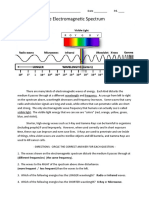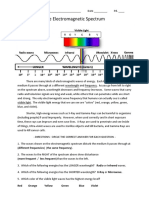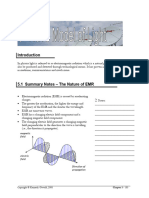Week-1-Learning-Activity-Sheet (4)
Week-1-Learning-Activity-Sheet (4)
Uploaded by
quinnzoneprintCopyright:
Available Formats
Week-1-Learning-Activity-Sheet (4)
Week-1-Learning-Activity-Sheet (4)
Uploaded by
quinnzoneprintCopyright
Available Formats
Share this document
Did you find this document useful?
Is this content inappropriate?
Copyright:
Available Formats
Week-1-Learning-Activity-Sheet (4)
Week-1-Learning-Activity-Sheet (4)
Uploaded by
quinnzoneprintCopyright:
Available Formats
Name: _______________________________________________ Date: _________________________________
LEARNING
Grade and Section: _____________________________________ Teacher _____________________________
ACTI VITY SHEET
WEEK 1: PETA 1: LEARNING ACTIVITY SHEET SCORE: _____ / 30
Directions: Below are descriptions of different terms relating to waves and the jumbled letters which will form the correct term.
Your task is to rearrange the jumbled letters to form the term being described.
Description & Jumbled Letters Rearranged Word
1. It is a disturbance in space. (AVWE) 1. _____________________________
2. It is the highest point in a wave. (SECRT) 2. _____________________________
3. It is the lowest point in a wave. (TGHURO) 3. _____________________________
4. It is the distance from the midpoint to the highest (or lowest) point of a wave. 4. _____________________________
(LMUPTDEAI)
5. It is the distance between two successive identical parts of a wave. 5. _____________________________
(ENEVTGWLAH)
6. It refers to the number of waves produced in one second. (NEGFCEURY) 6. _____________________________
7. It refers to the extent or the limits between which variation is possible. 7. _____________________________
(ARGNE)
Enrichment Activity 1
Directions: Determine the wavelength ranges of each of the forms of electromagnetic waves. Afterwards answer the questions
that follow.
Table 1. Electromagnetic Waves – Wavelength Ranges
Electromagnetic Wave Wavelength Range (meters) Electromagnetic Wave Wavelength Range (meters)
Radio wave Green
Microwave Blue
Infrared Violet
Visible Light Ultraviolet
Red x-ray
Orange Gamma Ray
Yellow
Guide Questions:
Q1. Which electromagnetic wave has the longest wavelength? ___________________________________________________
Q2. Which electromagnetic wave has the shortest wavelength? ___________________________________________________
Q3. Observe what happens to the wavelength of the electromagnetic waves as they progress (goes rightward from the figure).
Does the wavelength of the EM waves increase or decrease as we go from radio wave to gamma ray? __________
Enrichment Activity 2
Directions: Compare the frequencies of different EM waves, then answer the questions that follow.
Table 2. Electromagnetic Waves – Frequency Ranges
Electromagnetic Wave Frequency Range (Hertz) Electromagnetic Wave Frequency Range (Hertz)
Radio wave Green
Microwave Blue
Infrared Violet
Visible Light Ultraviolet
Red x-ray
Orange Gamma Ray
Yellow
Guide Questions:
Q1. Which among the EM waves has the highest frequency? _____________________________________________________
Q2. Which among the EM waves has the lowest frequency? ______________________________________________________
Q3. The energy of an EM wave also depends on its frequency, which means waves with higher frequency has higher energy too.
Which among the EM waves has the highest energy? _______________________________________________________
Q4. Which among the EM waves has the lowest energy? ________________________________________________________
Q5. What happens to the frequency of the electromagnetic waves as it progresses? Does the frequency of the EM waves
increase or decrease as we go from radio wave to gamma ray? __________
Directions: Pick out the word that will make the statements correct.
The electromagnetic spectrum is the arrangement of 1. (electromagnetic waves, ultraviolet radiation), which are waves that
are created with changing electric field and 2. (electric charge, magnetic field). EM waves travel on 3. (air, vacuum) at a
constant speed of 4. (3 x108 m/s, 8 x103 m/s).
The electromagnetic spectrum is arranged in a manner of 5. (decreasing, increasing) wavelength, 6. (decreasing, increasing)
frequency and 7. (decreasing, increasing) energy. 8. (Gamma ray, Radio wave) has the longest wavelength, lowest frequency
and lowest energy among all EM waves.
The 9. (radio wave, visible light) is the only EM wave that can be seen by our naked eye, whereas 10. (red, violet) has the
longest wavelength and 11. (red, violet) has the greatest frequency. On the other hand, 12. (gamma ray, radio wave) has the
shortest wavelength and highest frequency; which carries the highest 13. (energy, wavelength) among all EM waves. Therefore
14. (gamma ray, radio wave) has the lowest ionizing radiation, while 15. (gamma ray, radio wave) has the highest ionizing
radiation.
You might also like
- Sales (000 Units) : Plot The Monthly Data On A Sheet of Graph PaperNo ratings yetSales (000 Units) : Plot The Monthly Data On A Sheet of Graph Paper4 pages
- Science10 q2 Mod1of6 Electromagneticspectrum v2No ratings yetScience10 q2 Mod1of6 Electromagneticspectrum v215 pages
- Electromagnetic Radiation: Second Quarter - Performance Task #1No ratings yetElectromagnetic Radiation: Second Quarter - Performance Task #11 page
- Quarter 2: MODULE 1: Different Forms of EM Waves89% (9)Quarter 2: MODULE 1: Different Forms of EM Waves30 pages
- Q2 Week 3 SCiEd Staying Connected in Education New Normal Commun Ication EssentialsNo ratings yetQ2 Week 3 SCiEd Staying Connected in Education New Normal Commun Ication Essentials59 pages
- How Do Waves Propagate?: Activity 5 - Mechanical vs. Electromagnetic WavesNo ratings yetHow Do Waves Propagate?: Activity 5 - Mechanical vs. Electromagnetic Waves2 pages
- Sci10 Practical Applications of em WavesNo ratings yetSci10 Practical Applications of em Waves17 pages
- Unit 6 - Chapter 4 Section 1 Notes and Practice Honors ChemistryNo ratings yetUnit 6 - Chapter 4 Section 1 Notes and Practice Honors Chemistry4 pages
- Learning Activity Sheet Science 10 Second Quarter - Week 5No ratings yetLearning Activity Sheet Science 10 Second Quarter - Week 54 pages
- Laser Metrology in Fluid Mechanics: Granulometry, Temperature and Concentration MeasurementsFrom EverandLaser Metrology in Fluid Mechanics: Granulometry, Temperature and Concentration MeasurementsNo ratings yet
- Evaluation-Instrument-of-Supervisor-to-the-Student-InternNo ratings yetEvaluation-Instrument-of-Supervisor-to-the-Student-Intern4 pages
- Current Compensation Benefits Disclosure Form 2020No ratings yetCurrent Compensation Benefits Disclosure Form 20201 page
- Society For Research in Child Development, Wiley Child DevelopmentNo ratings yetSociety For Research in Child Development, Wiley Child Development9 pages
- Lesson: 5 Mathematics in The Modern WorldNo ratings yetLesson: 5 Mathematics in The Modern World12 pages
- Thermal Design Analysis of A Liquid Hydrogen VesselNo ratings yetThermal Design Analysis of A Liquid Hydrogen Vessel9 pages
- Computation of Symmetrical Free Standing Staircases100% (1)Computation of Symmetrical Free Standing Staircases6 pages
- Guru Jambheshwar University of Science & Technology Hisar NotificationNo ratings yetGuru Jambheshwar University of Science & Technology Hisar Notification3 pages
- Cybenetics - Evaluation - Report - COMPARISON - VTE Bronze 600WNo ratings yetCybenetics - Evaluation - Report - COMPARISON - VTE Bronze 600W16 pages
- Axpert VM III 4k6k Twin Off Grid - Manual 20221212No ratings yetAxpert VM III 4k6k Twin Off Grid - Manual 2022121264 pages
- Characteristics Value Description: Endress+Hauser Mon, 03 Aug 2020 Page 1 / 2No ratings yetCharacteristics Value Description: Endress+Hauser Mon, 03 Aug 2020 Page 1 / 22 pages









































































































